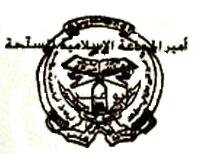
Armed Islamic Group of Algeria
The Armed Islamic Group (GIA, from French: Groupe Islamique Armé; Arabic: الجماعة الإسلامية المسلّحة, romanized: al-Jamāʿa al-ʾIslāmiyya al-Musallaḥa) was one of the two main Islamist insurgent groups that fought the Algerian government and army in the Algerian Civil War.
Armed Islamic Group
الجماعة الإسلامية المسلّحة
1993–2004
The creation of an Islamic state in Algeria
Tahar Djaout assassination, Djillali Liabes assassination, Cheb Hasni assassination, 1994, Air France Flight 8969 hijacking, January 1995 Algiers bombing, 1995 France bombings, Murder of the monks of Tibhirine, Lounès Matoub assassination, Hidroelektra workers massacre
It was created from smaller armed groups following the 1992 military coup and arrest and internment of thousands of officials in the Islamist Islamic Salvation Front (FIS) party after that party won the first round of parliamentary elections in December 1991. It was led by a succession of amirs (commanders) who were killed or arrested one after another. Unlike the other main armed groups, the Mouvement Islamique Arme (MIA) and later the Islamic Salvation Army (AIS), in its pursuit of an Islamic state the GIA sought not to pressure the government into concessions but to destabilise and overthrow it, to "purge the land of the ungodly".[2] Its slogan inscribed on all communiques was: "no agreement, no truce, no dialogue".[2] GIA's ideology was inspired by the Jihadist writings of the Egyptian Islamist scholar Sayyid Qutb.[1]
The group desired to create "an atmosphere of general insecurity"[2] and employed kidnapping, assassination, and bombings, including car bombs and targeted not only security forces but civilians. Between 1992 and 1998, the GIA conducted a violent campaign of civilian massacres, sometimes wiping out entire villages in its area of operation (notably those in Bentalha and Rais). It attacked and killed other Islamists who had left the GIA or attempted to negotiate with the government. It also targeted foreign civilians living in Algeria, killing more than 100 expatriate men and women in the country.
The group established a presence outside Algeria, in France, Belgium, Britain, Italy and the United States, and launched terror attacks in France in 1994 and 1995. The "undisputed principal Islamist force" in Algeria in 1994,[3] by 1996, militants were deserting "in droves", alienated by its execution of civilians and Islamist leaders.[4]
In 1999, a government amnesty law motivated large numbers of jihadis to "repent". The remnants of the GIA proper were hunted down over the next two years, leaving a splinter group the Salafist Group for Preaching and Combat (GSPC),[5] which announced its support for Al-Qaeda in October 2003.[6][7] The extent to which the group was infiltrated and manipulated by Algerian security services is disputed.[8][9][10][11][12]
The GIA is considered a terrorist organisation by the governments of Algeria, France, the United States, Argentina,[13] Bahrain,[14] Canada,[15] Japan,[16] New Zealand,[17] the United Kingdom[18] and the United Nations,.[19] The GIA remains a Proscribed Organisation in the United Kingdom under the Terrorism Act 2000.[20]
History[edit]
Founding[edit]
According to Algerian veterans of the Afghan jihad who founded the GIA, the idea of forming an armed group to fight jihad against the Algerian government was developed not after the coup but in 1989 after leaders of the Islamic Armed Movement (MIA) of Mustafa Bouyali, were freed from prison, but was not acted on due to the spectacular electoral political success of the FIS.[21] Embracing Sayyid Qutb's Takfir (excommunication) of secular governments and assertion that engaging in armed Jihad against Jaahili societies was mandatory; GIA leaders condemned the FLN regime as apostates and called upon Algerians to rise up, pledge allegiance to them and violently overthrow the socialist government in pursuit of establishing an Islamic state in Algeria. Support base of the GIA mainly consisted of the educationally and economically underprivileged classes of the Algerian society.[1]
Early in 1992, Mansour Meliani, a former aid to Bouyali, along with many "Afghans", broke with his former friend Abdelkader Heresay and left the MIA (Islamic Armed Movement), founding his own Jihadi group around July 1992. Meliani was arrested in July and executed in August 1993. Meliani was replaced by Mohammed Allal, aka Moh Leveilley, who was killed on 1 September 1992 by the Algerian military when they attacked a meeting held to unify command of the jihad.[22]
The economic state of Algeria was in a dire situation, where the majority of the young people were unemployed. In Algeria, there was no middle class, there were the rich and there were the poor, leaving many young people no hope for the future. The GIA was able to act as a place for young men to feel a part of something larger.